
Gilbert and Sullivan refers to the Victorian-era theatrical partnership of the dramatist W. S. Gilbert (1836–1911) and the composer Arthur Sullivan (1842–1900) and to the works they jointly created. The two men collaborated on fourteen comic operas between 1871 and 1896, of which H.M.S. Pinafore, The Pirates of Penzance and The Mikado are among the best known.

The Mikado; or, The Town of Titipu is a comic opera in two acts, with music by Arthur Sullivan and libretto by W. S. Gilbert, their ninth of fourteen operatic collaborations. It opened on 14 March 1885, in London, where it ran at the Savoy Theatre for 672 performances, the second-longest run for any work of musical theatre and one of the longest runs of any theatre piece up to that time. By the end of 1885, it was estimated that, in Europe and America, at least 150 companies were producing the opera.
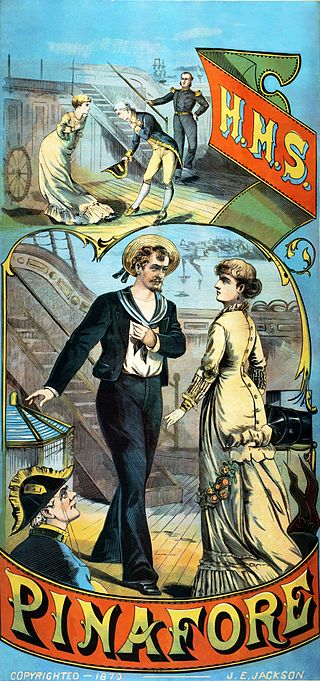
H.M.S. Pinafore; or, The Lass That Loved a Sailor is a comic opera in two acts, with music by Arthur Sullivan and a libretto by W. S. Gilbert. It opened at the Opera Comique in London on 25 May 1878, and ran for 571 performances, which was the second-longest run of any musical theatre piece up to that time. H.M.S. Pinafore was Gilbert and Sullivan's fourth operatic collaboration and their first international sensation.
A tenor is a type of classical male singing voice whose vocal range lies between the countertenor and baritone voice types. It is the highest male chest voice type. Composers typically write music for this voice in the range from the second B below middle C to the G above middle C (i.e. B2 to G4) in choral music, and from the second B flat below middle C to the C above middle C (B♭2 to C5) in operatic music, but the range can extend at either end. Subtypes of tenor include the leggero tenor, lyric tenor, spinto tenor, dramatic tenor, heldentenor, and tenor buffo or spieltenor.
A baritone is a type of classical male singing voice whose vocal range lies between the bass and the tenor voice-types. The term originates from the Greek βαρύτονος (barýtonos), meaning "heavy sounding". Composers typically write music for this voice in the range from the second F below middle C to the F above middle C (i.e. F2–F4) in choral music, and from the second G below middle C to the G above middle C (G2 to G4) in operatic music, but the range can extend at either end. Subtypes of baritone include the baryton-Martin baritone (light baritone), lyric baritone, Kavalierbariton, Verdi baritone, dramatic baritone, baryton-noble baritone, and the bass-baritone.
A contralto is a type of classical female singing voice whose vocal range is the lowest female voice type.
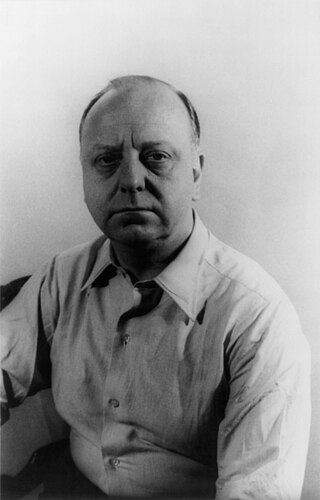
Virgil Thomson was an American composer and critic. He was instrumental in the development of the "American Sound" in classical music. He has been described as a modernist, a neoromantic, a neoclassicist, and a composer of "an Olympian blend of humanity and detachment" whose "expressive voice was always carefully muted" until his late opera Lord Byron which, in contrast to all his previous work, exhibited an emotional content that rises to "moments of real passion".

Etta Moten Barnett was an American actress and contralto vocalist, who was identified with her signature role of "Bess" in Porgy and Bess. She created new roles for African-American women on stage and screen. After her performing career, Barnett was active in Chicago as a major philanthropist and civic activist, raising funds for and supporting cultural, social and church institutions. She also hosted a radio program in Chicago and represented the United States in several official delegations to nations in Africa.
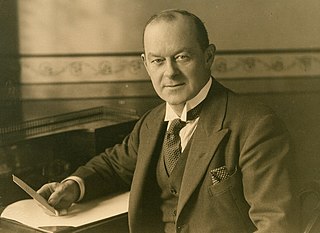
Peter Smith Dawson was an Australian bass-baritone and songwriter in the 1920s and 1930s, when he was possibly the most popular singer of that era. He said that at the time the gramophone was "an instrument of torture", excruciating for the recording artist, who needed "lungs of leather" to make an impression on the wax cylinders, which captured nothing but the very loudest noises.
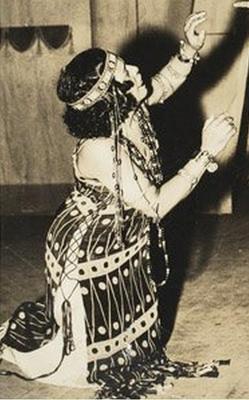
La Julia Rhea was an American operatic soprano.
Anthony Carl Tommasini is an American music critic and author who specializes in classical music. Described as "a discerning critic, whose taste, knowledge and judgment have made him a must-read", Tommasini was the chief classical music critic for The New York Times from 2000 to 2021. Also a pianist, he has released two CDS and two books on the music of his colleague and mentor, the composer and critic Virgil Thomson.

Treemonisha (1911) is an opera by American ragtime composer Scott Joplin. It is sometimes referred to as a "ragtime opera", though Joplin did not refer to it as such and it encompasses a wide range of musical styles. The music of Treemonisha includes an overture and prelude, along with various recitatives, choruses, small ensemble pieces, a ballet, and a few arias.

Sir Henry Lytton was an English actor and singer who was the leading exponent of the starring comic patter-baritone roles in Gilbert and Sullivan operas from 1909 to 1934. He also starred in musical comedies. His career with the D'Oyly Carte Opera Company spanned 50 years, and he is the only performer ever knighted for achievements in Gilbert and Sullivan roles.

Ivanhoe is a romantic opera in three acts based on the 1819 novel by Sir Walter Scott, with music by Sir Arthur Sullivan and a libretto by Julian Sturgis. It premiered at the Royal English Opera House on 31 January 1891 for a consecutive run of 155 performances, a record for a grand opera. Later that year it was performed six more times, making a total of 161 performances. It was toured by Carl Rosa Opera Company in 1894–1895 but has rarely been performed since. The first complete, fully professional recording was released in 2010 on the Chandos Records label.
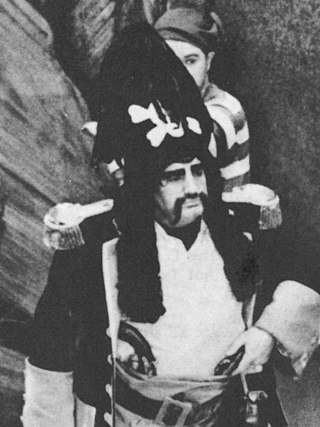
Charles Donald Adams was an English opera singer and actor, best known for his performances in bass-baritone roles of the Savoy operas with the D'Oyly Carte Opera Company and his own company, Gilbert and Sullivan for All.

Ernest George Pike was an English tenor of the early 20th century who made numerous recordings in the first decades of the 20th century. After studying at the Guildhall School of Music in London, he worked as a bank clerk and sang as a church tenor before making his first recording "Take a Pair of Sparkling Eyes" for the Gramophone & Typewriter Company in 1904. He became the house tenor for HMV and made several hundred records in a career that spanned over twenty years.

This is a timeline documenting events of jazz in the year 1924.

Richard Charles Watson was an Australian bass opera and concert singer and actor. He is probably best remembered for his performances and recordings of the comic bass-baritone roles of the Gilbert and Sullivan operas with the D'Oyly Carte Opera Company, but he appeared in a wide range of operas at the Royal Opera House and with the Carl Rosa Opera Company with such singers as Lotte Lehmann and Lauritz Melchior, under conductors including Sir Thomas Beecham and Bruno Walter.
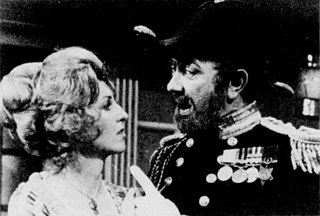
Michael Rayner was an English opera singer, best known for his performances in baritone roles of the Savoy Operas with the D'Oyly Carte Opera Company.

Development of musical theatre refers to the historical development of theatrical performance combined with music that culminated in the integrated form of modern musical theatre that combines songs, spoken dialogue, acting and dance. Although music has been a part of dramatic presentations since ancient times, modern Western musical theatre developed from several lines of antecedents that evolved over several centuries through the 18th century when the Ballad Opera and pantomime emerged in England and its colonies as the most popular forms of musical entertainment.














